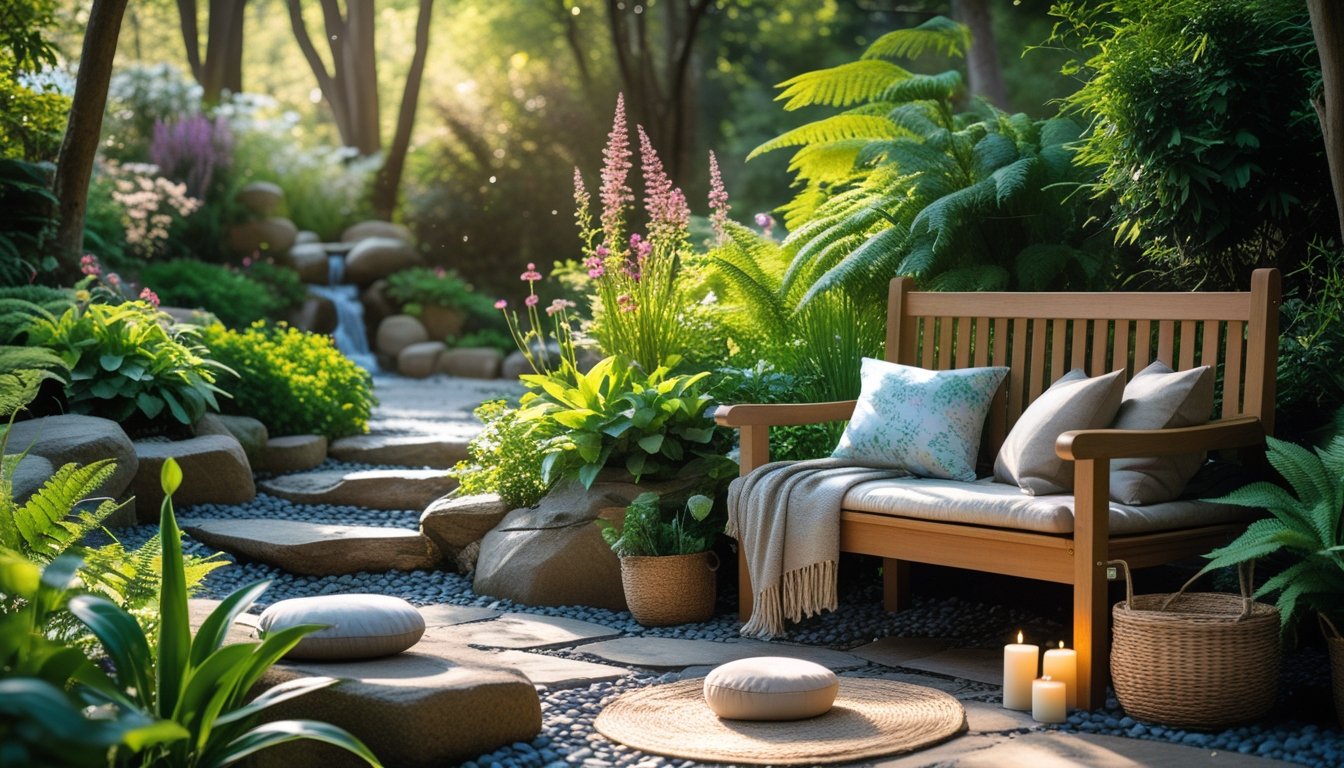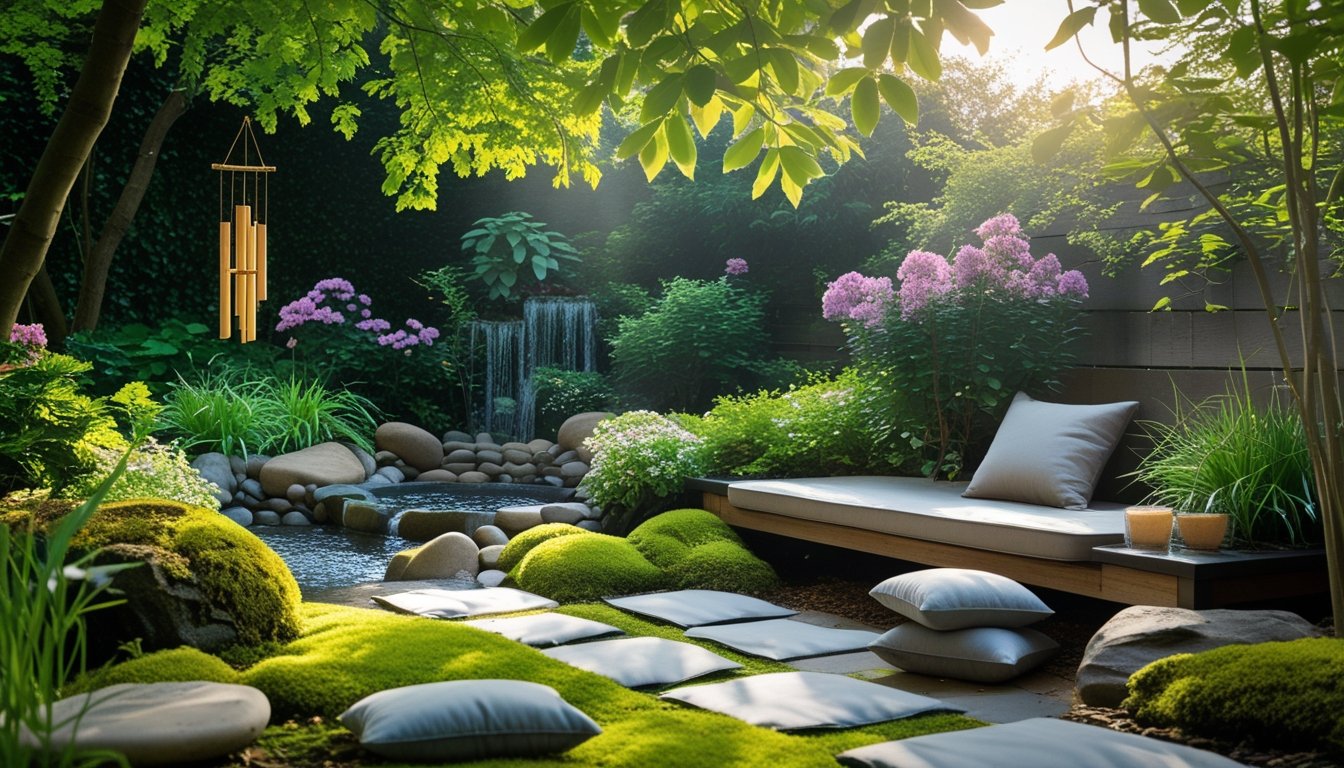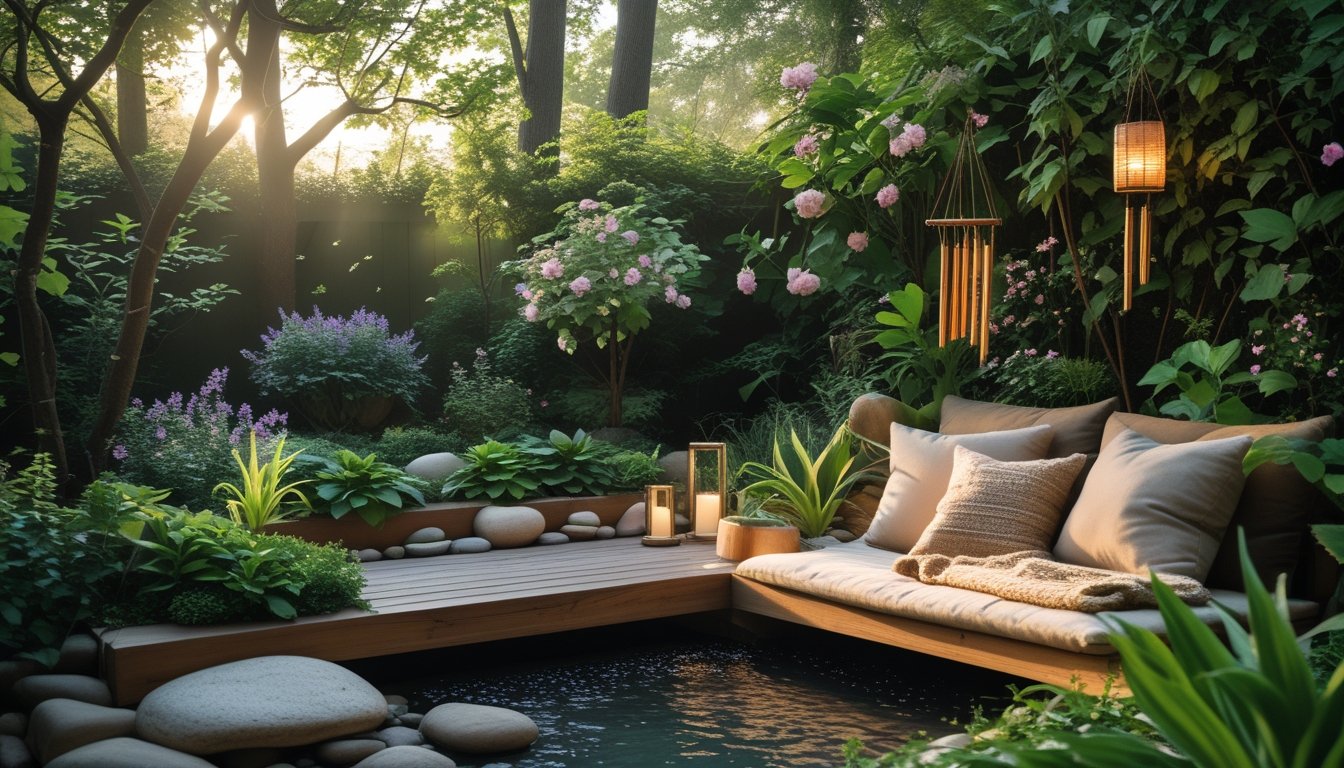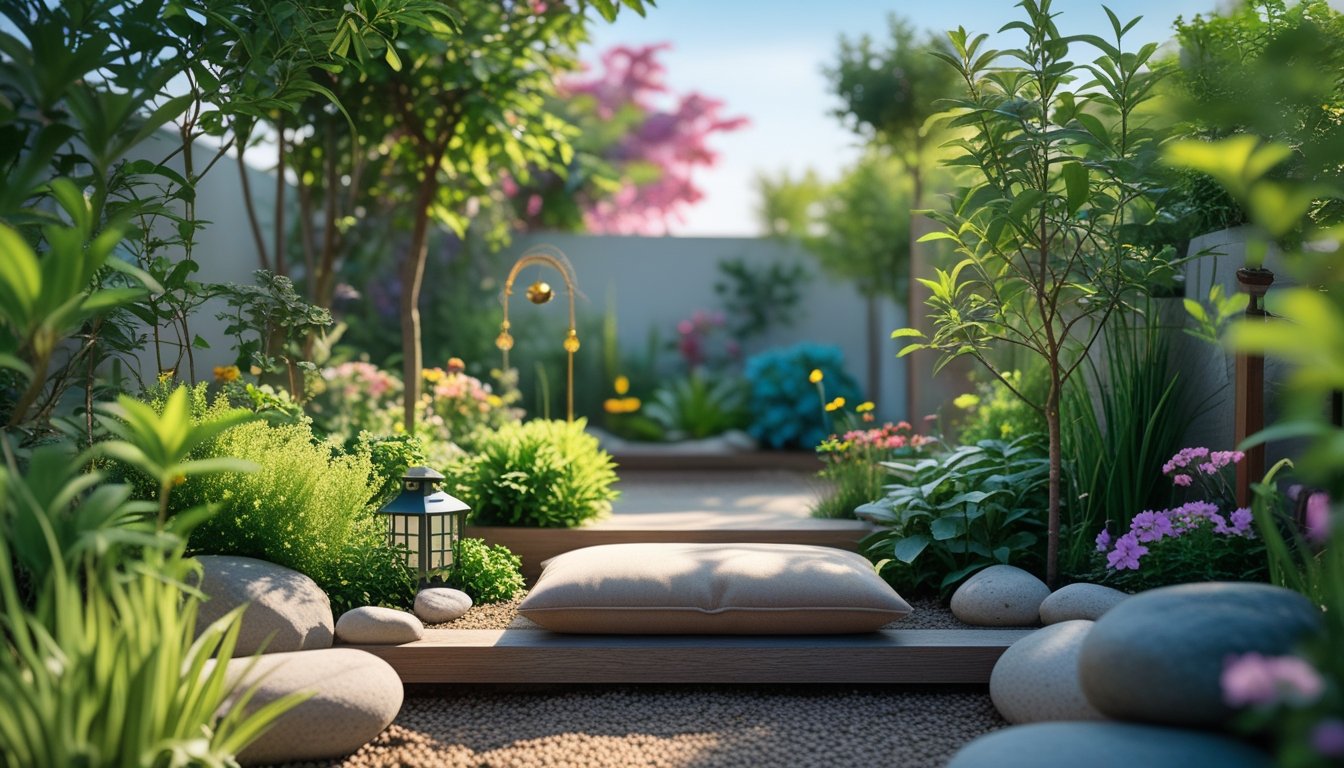Late updated: 11 Sep 2025 12:09
Written by: James Whitaker
Crafting A Peaceful Garden Meditation Nook: Tips For Tranquillity
Creating a meditation nook in your garden is a wonderful way to bring peace and relaxation into your daily life. Amidst the chaos of modern existence, a garden retreat provides a sanctuary where one can escape, reflect, and recharge. We can transform a simple outdoor space into a tranquil haven that enriches our well-being by utilising natural elements and mindful design.

Imagine wandering into your garden and feeling instantly calmed by the rustling leaves and gentle breeze. The natural world engages our senses, enhancing the meditation experience like no indoor space can. By selecting the right location and incorporating soothing elements, we can create a serene corner that supports our mental and emotional health.
Our mission is to guide you through the essential elements of crafting a peaceful garden meditation nook. Whether it's a spot under a shady tree or a vibrant flower-filled area, the possibilities are endless. Join us as we explore practical tips and creative ideas to make this dream a reality.
Key Takeaways
- Design a garden meditation nook for relaxation and well-being.
- Utilise natural elements to enhance the sensory experience.
- Discover tips for crafting a tranquil outdoor retreat.
Essential Elements for Crafting a Peaceful Garden Meditation Nook

When creating a peaceful garden meditation nook, several key elements can enhance the retreat experience. Selecting the right location and incorporating soothing natural elements play a crucial role in establishing a sanctuary for relaxation and introspection. Each choice contributes to creating a space that encourages mindfulness and tranquility.
Choosing the Ideal Location for Seclusion
Finding the perfect quiet corner of the garden can significantly enhance the serenity of our meditation space. We should look for a spot that offers natural shade, perhaps under a tree or with the use of shade sails.
Morning sunlight can add warmth and pleasant light to the area. Selecting locations buffered by surrounding shrubs or walls can provide additional seclusion, transforming a garden nook into a secret garden nook. Creating boundaries with tall grasses or bamboo helps to maintain privacy and creates a peaceful sanctuary right in our backyard.
Selecting Calming Plants and Fragrant Herbs
Calming plants and fragrant herbs are essential for crafting a serene atmosphere. We can incorporate potted plants such as lavender, rosemary, and jasmine to engage our senses and enhance the tranquillity of the meditation garden.
These plants not only emit pleasant scents but also invite pollinators, adding life and interaction to our serene garden nook. Succulents and ornamental grasses can provide visual appeal with their diverse textures. Introducing mint among the plants can offer additional fragrance and the added benefit of use in herbal teas, further connecting us with the natural elements of our outdoor space.
Incorporating Soothing Water Features
Water features can be instrumental in establishing a peaceful sanctuary. A small fountain or gentle waterfall can add a soothing sound, aiding in meditation and mindfulness. The calming flow of water brings a sense of movement and dynamism, yet retains the peace that a garden needs.
We might even consider installing a small pond with water lilies, creating a visually appealing and tranquil setting. The presence of water encourages a serene atmosphere that supports introspection and peace, transforming any garden corner into a personal retreat.
Establishing Comfortable and Inviting Seating
Comfortable seating is pivotal in enjoying our meditation garden. Options such as a rustic wooden bench or modern floor cushions can cater to different preferences. Yoga mats are an excellent addition for those who might use the space for meditation or yoga sessions.
Creating a reading nook adds versatility and invites leisure activities beyond meditation. It's important that the seating is inviting and comfortable, encouraging us to spend more time in the garden sanctuary. Choosing materials that withstand the elements ensures that the seating remains aesthetically pleasing and functional throughout the seasons. This careful consideration ensures our outdoor space serves as a true retreat.
Design Features to Enhance Serenity and Ambience

Integrating the right design features can transform a garden nook into a haven of peace and relaxation. Effective use of lighting, sensory elements, and vertical structures can create an inviting atmosphere where one can unwind and practise mindfulness.
Incorporating Ambient and Solar Lighting
Lighting plays a pivotal role in setting the mood of your meditation nook. String lights and hanging lanterns provide a soft glow that transforms any outdoor area into a magical retreat. A mix of ambient lighting options can enhance the atmosphere.
Solar-powered garden lamps and solar-powered lanterns are excellent choices for those looking to incorporate eco-friendly options. They charge during the day and provide energy-efficient illumination at night, ensuring your garden remains well-lit without excessive electricity use. Proper lighting not only boosts aesthetics but also adds functionality, extending the usability of your garden nook into the evenings.
Adding Sensory Details for Mindfulness
Sensory elements can heighten our sense of presence in a garden nook. Wind chimes add gentle, melodious tones that change with the breeze, while bird feeders invite local wildlife, enriching the experience with natural sounds and sights.
Incorporating small fountains or tabletop fountains adds a soothing auditory element, creating a calming water trickle. Plants such as fragrant herbs can stimulate our sense of smell, enhancing peace and mindfulness. These elements create a multi-sensory environment that fosters deeper relaxation and reflection.
Utilising Vertical Gardens and Creative Structures
Vertical structures can maximise space and add depth to a garden retreat. Trellises, pergolas, and arbors are ideal for supporting climbing vines and establishing a sense of enclosure, promoting privacy.
A vertical garden nook allows for a lush display of greenery in compact spaces, adding texture and interest. Decking with stone pathways offers a structured foundation. Including side tables or ottomans provides practical places to rest essentials or simply relax. These arrangements effectively use space, creating an inviting visual and physical structure without sprawling over landscapes. This harmonises the area, drawing eyes upwards and around the garden, adding to its overall allure.
Frequently Asked Questions

In crafting a peaceful garden meditation nook, one should carefully consider various elements, such as choosing the right location, suitable plants, and effective design features. The following questions address common concerns.
What are the essential elements for creating a tranquil garden meditation space?
Key components include selecting calming plants, ensuring privacy, and incorporating comfortable seating. Integrating natural features like a small water element or natural stones can add to the tranquillity. These help foster a peaceful environment conducive to meditation.
How can one choose the best location for a meditation nook within a garden?
Select an area that offers a balance of sun and shade to maximise comfort. It's also wise to position the nook away from noisy or distracting areas. Consider how the space feels at different times of the day to find the most serene spot.
Which plants are recommended for fostering a serene atmosphere in a meditation area?
Opt for plants known for their calming effects, such as lavender, jasmine, and chamomile. Including greenery like ferns or grasses can also enhance the soothing ambiance. Fragrant plants can engage the senses and promote relaxation.
What are some effective design tips for ensuring privacy in a garden meditation nook?
Use natural barriers like hedges or bamboo screens to provide seclusion. Consider adding a trellis with climbing plants or using tall pots to define the space. Privacy is crucial for maintaining an uninterrupted meditation practice.
How should I maintain my meditation space to enhance its calming qualities?
Regular maintenance is vital, such as trimming plants and ensuring the area is clean and clutter-free. Refresh seating and decor periodically to maintain a peaceful environment. Keeping the space well-kept promotes an ongoing sense of calm.
What types of seating should be considered for comfort and relaxation in a garden meditation space?
Choose seating that provides both comfort and support, like a cushioned bench or a weather-resistant chair. Portable cushions can offer flexibility, allowing us to adapt to various meditation positions. The material should be durable and suitable for outdoor conditions.
